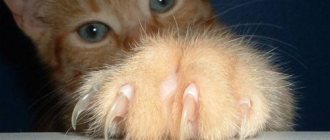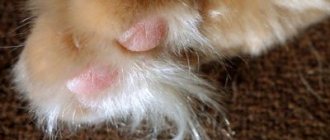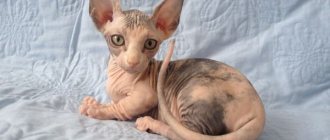Skin diseases occupy a leading place not only among people, but also among pets. Ulcers and ulcers can appear anywhere, from the head to the tail. Pododermatitis in cats is a skin disease of the animal's paw pads.
He suddenly loses mobility, lies on his back a lot, meows loudly. Pododermatitis itself is not dangerous, but it is unacceptable for active animals. In addition, if the disease is neglected, it will lead to serious health problems.
In today's article we will talk about pododermatitis in cats, its causes, methods of treatment and prevention. Let's consider popular questions from owners and find out the most popular methods for getting rid of the disease.
Causes
So, the described sore manifests itself as inflammation of the paw pads. They can crack, forming wounds. The paws peel and dead pieces of skin fall off easily. Then the damaged areas will heal, but after a while they will dry out again.
ATTENTION! Plasmacytic pododermatitis is unique to cats.
The disease affects animals at any age, regardless of breed and living conditions. Pododermatitis occurs less frequently on the pads between the fingers. The clinical picture looks like this:
- Your cat's paw pads are swollen
- Despite the swelling, when pressed they are soft and do not cause pain.
- With severe swelling, the damaged areas acquire a purple tint and may burst, revealing wounds and ulcers.
- An open wound is a favorable environment for pathogenic microorganisms, given that the cat constantly licks the damaged areas.
There may be several causes of plasmacytic pododermatitis . Let's look at the most common of them:
- The development of pathogenic microorganisms - these include Staphylococcus aureus, certain types of streptococci, as well as some strains of Escherichia coli. Any careless wound to the paw can lead to infection.
- Fungal infection is dangerous because in most cases it leads to a chronic form. The disease can be overcome for a while, but it will return again and again. The fungal nature is extremely difficult to treat. The veterinarian prescribes the optimal course, but even after drinking it completely, there is no guarantee that the sore will not return.
- Allergic reaction – there are a huge number of options: from plant pollen to tobacco smoke. A cat may simply burn itself on the grass or contract dermatitis on its pads after contact with stray animals. You can often find runaway pets near trash cans. After he returns home, the disease progresses.
- Environmental factors are a clear example of this: allergies to household chemicals. Nowadays there are many different shampoos, gels and similar substances on sale. A number of them can cause irritation, the pads become inflamed, crack, forming deep wounds.
In winter the chance is higher. An animal can get frostbite on its paws in severe frost . All this will lead to paw pads swelling and cracking. By the way, in this situation, it goes away after a little treatment. But there is no guarantee that pathogenic microorganisms will not enter the wound during this time.
Analysis of the main reasons
In some cases, a visual inspection is enough to understand what is wrong with the animal. But, if a cat’s paw pads are peeling and there is itching and redness, then a cytological examination of scales or fluid taken from the lesion must be performed.
This is necessary in order to exclude or confirm the possibility of fungal or bacterial infection, which may occur against the background of allergies. Therefore, if your pet’s skin peels off its paw pads, consider the following options first.
Allergy
Most often it causes the skin of a cat to peel off its paw pads. It can be provoked not only by food allergies (rarely affecting the extremities), but also by contact dermatitis.
The reaction is especially painful in decorative breeds (Sphynx, Exotic, Maine Coon, British, etc.). Poor nutrition can cause a number of skin and coat problems. An allergic reaction almost always involves itching and redness.
If a secondary infection occurs, a large wound may form on the paw due to scratching and licking. For small lesions, it is recommended to start with a change in food; in complex cases, systemic treatment with a combination of antihistamines and broad-spectrum antibiotics is indicated.
Foreign body
It can cause a lot of trouble if not removed in time. At first, you can notice how the pet limps on one leg, then it even begins to tuck it in, as it feels severe pain when stepping on it.
The inflammatory process can cause redness, swelling and purulent discharge. If a cat's paw pads are peeling, then the possibility of bacterial infection, which is often present in inflammatory processes, should be excluded.
If it is not possible to remove the splinter on your own (fish bone, glass, wood chips), then the animal must be taken to the veterinarian. There, using special instruments, they will remove even the smallest splinter, remove the pus (if there is any), treat the wound with an antiseptic and prescribe anti-inflammatory ointment.
Injury
It also does not ignore the paws, especially in the area between the toes. It is especially common in street animals that come into contact with different surfaces (asphalt, primer, etc.). Damage can also occur after falling from a height and while climbing trees.
In most cases, the injured limb swells, the skin peels off the pad, and the spaces between the toes turn red. Small cracks heal within a few days. Deep cuts may bleed heavily and be painful when walking.
It is recommended to treat all open wounds in the extremity area with an antiseptic solution to prevent the development of an infectious process.
Plasmacytic pododermatitis
It occurs much less frequently than all of the above, but the clinical picture is very similar to the manifestations of allergies or bacterial damage. But, unlike other pathologies associated with limbs, PPD spreads to several paws at once (at least two).
It manifests itself in the form of swelling and redness of the interdigital spaces, the paw pads peel off and change color (most often to pink or light red).
The most negative aspect of PPD is that it brings a lot of discomfort to the animal , and in some cases, terrible suffering. Due to constant pain, the pet once again does not want to move, so as not to step on its paws. Diagnosis may require a biopsy and cytological and histological examination.
Treatment depends on the severity of the clinical picture. For small lesions, you can get by with conventional antiseptic treatment and compresses based on levomekol, since plasmacytic pododermatitis is prone to spontaneous regression. In difficult cases, broad-spectrum antibiotics (Sinulox, Prednisolone) are used.
Symptoms of the disease
A healthy cat's paw pads are pink, smooth and normally dry. At the first stage, the paws increase slightly in size, which does not cause concern to the animal. Next, the affected areas become wet and cyanosis appears.
Pododermatitis is poorly visible in black cats. It is worth paying attention to the fact that the hair around the affected areas falls out, and the paw pads themselves peel off after running your finger over them.
Over time, the damaged areas acquire a purple tint, which turns into red spots. They swell, burst and expose ulcers. Wounds on the paw pads bleed profusely . This causes severe pain to the pet.
This period is dangerous because infection (especially fungal) can easily penetrate the wounds. All this is fraught with complications and a sharp drop in the animal’s immunity. A sure sign of secondary infection is a fetid, purulent odor from your pet’s paws.
In this case, the cat licks damaged areas, bites hair or skin, which promotes the unhindered spread of microorganisms throughout the body.
ATTENTION! Restless itching and lameness are characteristic of the last stages of pododermatitis, when no treatment was taken and the sore was discovered too late.
Associated symptoms include: inflammation of the lymph nodes, swelling of the back of the nose. Advanced pododermatitis leads to such serious diseases as amyloidosis (protein metabolism disorder) and glomerulonephritis (kidney damage).
Competent diagnosis will allow you to exclude other diseases . For example, eosinophilic granuloma or pemphigus foliaceus.
Clinical picture and diagnosis
Whatever the cause of the disease in each specific case, the clinical picture will be quite characteristic. So, what are the symptoms of pododermatitis in cats? At first, you may notice that your pet has begun to pay too much attention to its personal hygiene. This is expressed in constant licking and “gnawing” of their paws. This is how the cat tries to get rid of itching and other unpleasant sensations that always accompany the appearance of pododermatitis.
Alas, most often most owners do not pay the slightest attention to these signs. This way the process gets the opportunity to develop further. When this happens, ulcers and wounds appear on the cat’s paws, and it comes to purulent inflammation.
At the same time, the paw pads become very soft and begin to bleed, and sometimes the claws fall out. The animal cannot walk normally and take care of itself, constantly sits in one place, and reacts extremely negatively to attempts to examine its paws. If after this you do not provide him with medical assistance, then things may lead to exposed bones and massive tissue necrosis. It all ends with sepsis and death.
Diagnosing the disease is quite simple. The veterinarian looks at the existing clinical picture, if necessary, pathological material is taken for microscopic examination, inoculation on nutrient media, and the sensitivity of the identified pathogens to various antibacterial agents is determined. So what treatment for pododermatitis in cats should be used to prevent this outcome?
Treatment
In the first stages it is extremely difficult to recognize the disease, but the sooner this happens, the higher the chance of a quick recovery. It is worth understanding that small areas may go away on their own, but in the event of a total defeat, you should not hope for this.
What medications do veterinarians recommend?
- Systemic glucocorticosteroids (Prednisolone or Methylprednisolone). Used in increased doses with a gradual reduction after the first improvement. The initial dose for Prednisolone is 2-4 mg per kg of the pet’s body 2 times a day.
- Antibiotics (Dioxycycline and Vibramycin). The first drug is used more often. Dosage 10 mg per kg of animal body. The course lasts 4-6 weeks depending on the severity.
- Triamcinolone or dexamethasone successfully fight skin diseases. Dosage: 0.4-0.6 mg per kg once a day. After visible improvements, the drug is given every other day.
- To strengthen the immune system, they give dietary supplements, mineral complexes and other additives. For example, Vitamin E (50 mg per day).
- Surgery. It involves removing the affected areas. It is used in situations where drug treatment is ineffective or pododermatitis has reached its final stage. The animal cannot walk and is in pain. After the intervention of veterinarians, the disease disappears completely. The chance of relapse is extremely rare.
Pododermatitis is a harmless skin disease that can be caused by hypothermia, allergies or a fungal infection. The paw pads crack and the wounds bleed. In this case, the affected areas are bright purple. In the later stages, ulcers open. Re-infection with pathogenic microflora is possible.
Veterinarians most often use a course of antibiotics or glucocorticosteroids, diluting the treatment with vitamins and minerals. Surgery can effectively treat the disease, but it is used only in severe cases when medications do not lead to a positive result.











